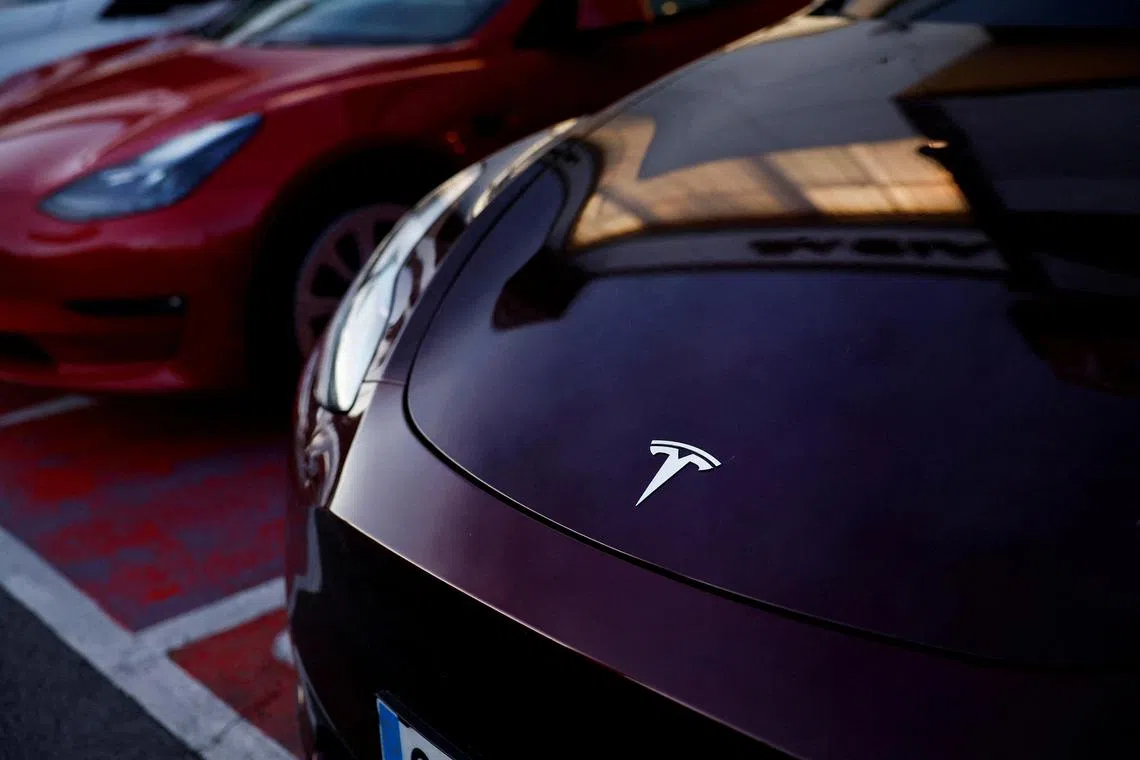US toddler trapped in Tesla car with dead battery amid heatwave
Sign up now: Get ST's newsletters delivered to your inbox

While Tesla has manual release doors inside the car for when one is locked in, they are unmarked.
PHOTO: REUTERS
A 20-month-old girl’s life was recently in jeopardy when she was locked inside a Tesla Model Y, after the car’s battery died without warning in the middle of an ongoing Arizona heatwave.
The girl’s grandmother, Ms Renee Sanchez, told local news outlet Arizona’s Family that she had placed the toddler in the car seat for a trip to the Phoenix Zoo.
She said: “I closed the door, went around the car to (get into) the front seat, and my car was dead... I could not get in. My phone key wouldn’t open it. My card key wouldn’t open it.”
It is not clear exactly when the incident occurred.
Left with no other option, Ms Sanchez called the local fire department for help. Firefighters used an axe to break the car’s window before climbing through to pull the toddler out.
Ms Sanchez recalled the firefighters saying upon arriving at the scene: “‘It’s a Tesla. We can’t get in these cars.’
“And I said, ‘I don’t care if you have to cut my car in half. Just get her out’.”
New York-based news outlet The Verge reported that a Tesla Model Y without power can be opened from inside the vehicle through a latch which opens the front door, as well as a cable to access the back door.
But that was not possible in this case, as the young child was buckled into her car seat and Ms Sanchez was locked out of the car.
The Verge reported that it is also possible to get into to a dead Tesla by jump-starting its 12-voltage battery, which powers the vehicle’s electrical systems, including door access.
It can, however, be a complicated process.
According to American news outlet Fortune, one would have to open a three-inch circle near the front of the car called a toe cover, pull out the cables inside it and connect them to an external power supply, opening the hood of the trunk for drivers to access the battery.
Neither Ms Sanchez nor the firefighters at the scene knew about this mechanism, reported Fortune.
Executive director of non-profit Centre for Auto Safety Michael Brooks told Fortune that a toddler can become critically endangered within 15 minutes of being trapped in a car amid the Arizona heat.
Many children have died after being trapped for more than 30 minutes, he added.
Temperatures in Arizona have hovered above 37.7 deg C the past week.
While Ms Sanchez’s granddaughter came out of the incident unscathed, she said the girl was very scared and started crying during the commotion.
“After I knew she was safe, then the anger (came),” said Ms Sanchez, adding that she started thinking about how much worse the outcome could have been.
Electric vehicle (EV) expert Mike Klimkosky told Fortune that Tesla cars are supposed to have persistent warning signs when the batteries are low, so it “seems very odd” that Ms Sanchez’s battery would simply turn off.
The Tesla service department has confirmed that Ms Sanchez had not received any warnings, US media reported. Tesla did not respond to further media queries.
This incident comes amid ongoing debates on whether Tesla has sufficient safety features for emergency situations, with numerous reports of people being locked inside their Tesla cars having surfaced.
But Mr Klimkosky, who runs a non-profit which teaches first responders EV safety, said that the responsibility should be on firefighters to educate themselves on how to jump-start Tesla cars.
He added that this process would be faster and easier than breaking into the car.
Like most other car manufacturers, Tesla has an emergency response guide on their websites available to first responders, he said, adding that the onus is not on manufacturers to continue educating firefighters.
Mr Brooks, however, said it was “absurd” to blame the firefighters for not knowing how to get into the car.
“It’s not the firefighters’ fault that Tesla chose electronic door latches that don’t have proper emergency safeguards,” he said.
While Tesla has manual release doors inside the car for when one is locked in, they are unmarked – which Mr Brooks said was the manufacturer’s choice to put “form over function” and was ultimately “unsafe”.
Mr Brooks also said there are thousands of first responders and at least 150 different types of vehicles, adding that firefighters cannot be expected to memorise the safety procedure of every vehicle.
Tesla in 2023 recalled more than two million vehicles in the US
In April, US auto safety regulators opened an investigation


